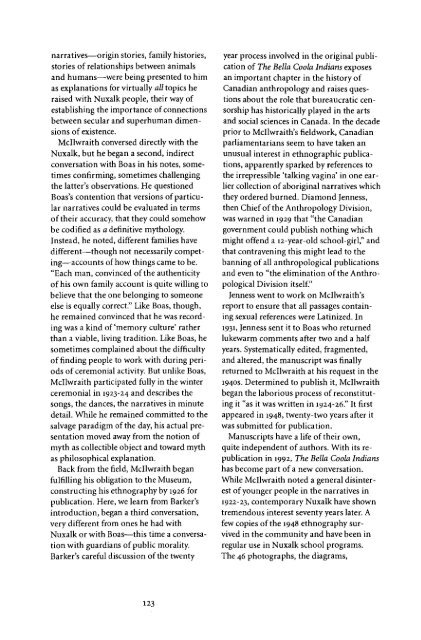To All Appearances A Lady - University of British Columbia
To All Appearances A Lady - University of British Columbia
To All Appearances A Lady - University of British Columbia
You also want an ePaper? Increase the reach of your titles
YUMPU automatically turns print PDFs into web optimized ePapers that Google loves.
narratives—origin stories, family histories,<br />
stories <strong>of</strong> relationships between animals<br />
and humans—were being presented to him<br />
as explanations for virtually all topics he<br />
raised with Nuxalk people, their way <strong>of</strong><br />
establishing the importance <strong>of</strong> connections<br />
between secular and superhuman dimensions<br />
<strong>of</strong> existence.<br />
Mcllwraith conversed directly with the<br />
Nuxalk, but he began a second, indirect<br />
conversation with Boas in his notes, sometimes<br />
confirming, sometimes challenging<br />
the latter's observations. He questioned<br />
Boas's contention that versions <strong>of</strong> particular<br />
narratives could be evaluated in terms<br />
<strong>of</strong> their accuracy, that they could somehow<br />
be codified as a definitive mythology.<br />
Instead, he noted, different families have<br />
different—though not necessarily competing—accounts<br />
<strong>of</strong> how things came to be.<br />
"Each man, convinced <strong>of</strong> the authenticity<br />
<strong>of</strong> his own family account is quite willing to<br />
believe that the one belonging to someone<br />
else is equally correct." Like Boas, though,<br />
he remained convinced that he was recording<br />
was a kind <strong>of</strong>'memory culture' rather<br />
than a viable, living tradition. Like Boas, he<br />
sometimes complained about the difficulty<br />
<strong>of</strong> finding people to work with during periods<br />
<strong>of</strong> ceremonial activity. But unlike Boas,<br />
Mcllwraith participated fully in the winter<br />
ceremonial in 1923-24 and describes the<br />
songs, the dances, the narratives in minute<br />
detail. While he remained committed to the<br />
salvage paradigm <strong>of</strong> the day, his actual presentation<br />
moved away from the notion <strong>of</strong><br />
myth as collectible object and toward myth<br />
as philosophical explanation.<br />
Back from the field, Mcllwraith began<br />
fulfilling his obligation to the Museum,<br />
constructing his ethnography by 1926 for<br />
publication. Here, we learn from Barker's<br />
introduction, began a third conversation,<br />
very different from ones he had with<br />
Nuxalk or with Boas—this time a conversation<br />
with guardians <strong>of</strong> public morality.<br />
Barker's careful discussion <strong>of</strong> the twenty<br />
year process involved in the original publication<br />
<strong>of</strong> The Bella Coola Indians exposes<br />
an important chapter in the history <strong>of</strong><br />
Canadian anthropology and raises questions<br />
about the role that bureaucratic censorship<br />
has historically played in the arts<br />
and social sciences in Canada. In the decade<br />
prior to Mcllwraith's fieldwork, Canadian<br />
parliamentarians seem to have taken an<br />
unusual interest in ethnographic publications,<br />
apparently sparked by references to<br />
the irrepressible 'talking vagina' in one earlier<br />
collection <strong>of</strong> aboriginal narratives which<br />
they ordered burned. Diamond Jenness,<br />
then Chief <strong>of</strong> the Anthropology Division,<br />
was warned in 1929 that "the Canadian<br />
government could publish nothing which<br />
might <strong>of</strong>fend a 12-year-old school-girl," and<br />
that contravening this might lead to the<br />
banning <strong>of</strong> all anthropological publications<br />
and even to "the elimination <strong>of</strong> the Anthropological<br />
Division itself."<br />
Jenness went to work on Mcllwraith's<br />
report to ensure that all passages containing<br />
sexual references were Latinized. In<br />
1931, Jenness sent it to Boas who returned<br />
lukewarm comments after two and a half<br />
years. Systematically edited, fragmented,<br />
and altered, the manuscript was finally<br />
returned to Mcllwraith at his request in the<br />
1940s. Determined to publish it, Mcllwraith<br />
began the laborious process <strong>of</strong> reconstituting<br />
it "as it was written in 1924-26." It first<br />
appeared in 1948, twenty-two years after it<br />
was submitted for publication.<br />
Manuscripts have a life <strong>of</strong> their own,<br />
quite independent <strong>of</strong> authors. With its republication<br />
in 1992, The Bella Coola Indians<br />
has become part <strong>of</strong> a new conversation.<br />
While Mcllwraith noted a general disinterest<br />
<strong>of</strong> younger people in the narratives in<br />
1922-23, contemporary Nuxalk have shown<br />
tremendous interest seventy years later. A<br />
few copies <strong>of</strong> the 1948 ethnography survived<br />
in the community and have been in<br />
regular use in Nuxalk school programs.<br />
The 46 photographs, the diagrams,<br />
123

















